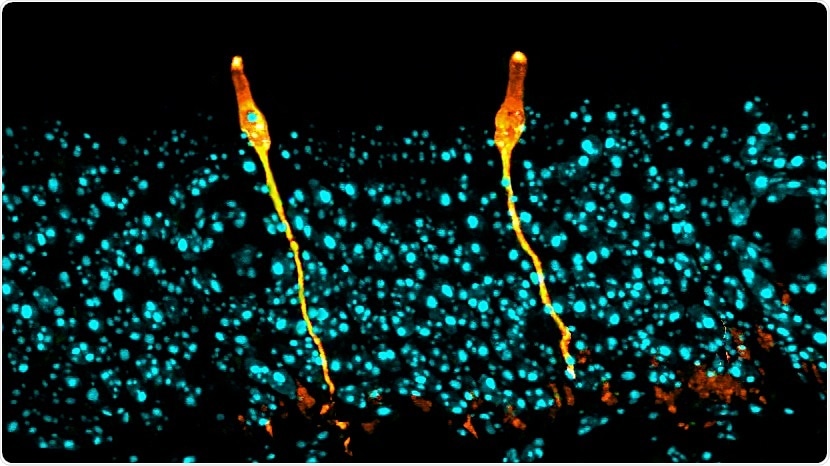
Discovery of new epithelial lung cell type may affect cystic fibrosis therapy
Scientists have discovered a new type of cell in the human respiratory tract called the pulmonary ionocyte, and linked it to lung function decline in cystic fibrosis.
 Image Credit: Montoro et al. Nature 2018
Image Credit: Montoro et al. Nature 2018Pulomonary ionocytes make up about one percent of the cells in the lung and are thought to be responsible for cystic fibrosis, the incurable multiorgan disease which affects more than 70 000 people around the world.
The cell resembles an ionocyte, a type of cell found in the gills of freshwater fish and the skin of frogs which control salt levels within the bodies of these animals.
Pulmonary ionocytes are rich in CFTR gene expression and their number is related to the level of activity of this gene. The greater the number of pulmonary ionocytes, the higher the level of CFTR activity.
Until now, it was thought that CFTR is expressed at low levels in ciliated cells, a type of cell which is common within the airway epithelium. Mutations in CFTR are linked to the occurrence of cystic fibrosis.
What is CFTR?
Pulmonary ionocytes express the CFTR gene at a higher level than any other cell. The CFTR (cystic fibrosis transmembrane conductance regulator) gene encodes the cellular protein that operates to transport chloride ions across the cell membrane, a process which is crucial for normal cell secretory activity.
CFTR mutations cause the mucus in the respiratory tract and pancreas to become thick and tenacious. This accumulates to cause frequent and repeated blockage and infections of these organs, producing damage and eventual failure.
In one of the studies, when the function of these cells was disrupted, the resulting changes mirrored those found in cystic fibrosis, which shows their importance in the regulation of ion traffic at the cell surface.
Aron Jaffe, one of the leaders of the second study "A single-cell atlas of the airway epithelium reveals the CFTR-rich pulmonary ionocyte", pointed out that the results obtained by both teams could help develop more successful therapies for cystic fibrosis, such as increasing CFTR activity by boosting the pulmonary ionocyte number in lung tissue.
Making sense of the airway
Both studies used single cell sequencing technology to analyze thousands upon thousands of cells taken from the human and mouse airway individually.
The teams built up a genetic catalog of lung cells, known and unknown, by cell type, cell states, frequency and location.
One team used an innovative method, Pulse-Seq, to identify the common lung cell progenitor called the basal cell and the cells developing from it.
The other team used InDrops , a technology produced by HMS, to follow the transitional cell states occurring during the regeneration process after cell injury.
The studies also traced cell populations which express certain genes linked to specific diseases. For instance ciliated cells which are linked to a gene associated with asthma were traced, and tuft cells were examined, some of which recognize the presence of chemicals in the respiratory tract while others respond by the development of inflammation.
One team was from Harvard Medical School (HMS) and the Novartis Institutes for Biomedical Research (NIBR) while the other was led by scientists also from HMS but working at Massachusetts General Hospital, along with others at the Broad Institute of MIT and Harvard. Both studies were recently published in Nature.






















.jpg)












No hay comentarios:
Publicar un comentario